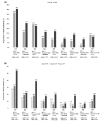Understanding the Prevalence and Associated Factors of Behavioral Intention of COVID-19 Vaccination Under Specific Scenarios Combining Effectiveness, Safety, and Cost in the Hong Kong Chinese General Population
- PMID: 33619928
- PMCID: PMC9808181
- DOI: 10.34172/ijhpm.2021.02
Understanding the Prevalence and Associated Factors of Behavioral Intention of COVID-19 Vaccination Under Specific Scenarios Combining Effectiveness, Safety, and Cost in the Hong Kong Chinese General Population
Abstract
Background: The prevalence of coronavirus disease 2019 (COVID-19) vaccination is very critical in controlling COVID-19. This study mainly aimed to (1) investigate behavioral intentions of COVID-19 vaccination under various specific scenarios, and (2) associated factors of the afore-mentioned vaccination intentions.
Methods: A random anonymous telephone survey interviewed 450 Chinese adults from September 16-30, 2020 in Hong Kong, China. Nine scenarios of behavioral intentions of COVID-19 vaccinations were measured combining effectiveness (80% versus 50%), safety (rare versus common mild side effect), and cost (free versus HK$ 500).
Results: The prevalence of behavioral intentions of COVID-19 vaccination under the 9 specific scenarios was very low and varied greatly (4.2% to 38.0%). The prospective countries of manufacture also influenced vaccination intention (eg, Japan: 55.8% vs China: 31.1%). Only 13.1% intended to take up COVID-19 vaccination at the soonest upon its availability. The attributes of effectiveness and side effect influenced vaccination intention most. Positively associated factors of behavioral intentions of COVID-19 vaccination included trust/satisfaction toward the government, exposure to positive social media information about COVID-19 vaccines, descriptive norms, perceived impact on the pandemic, perceived duration of protectiveness, and life satisfaction.
Conclusion: Intention of COVID-19 vaccination was low in the Hong Kong general population, especially among younger people, females, and single people. Health promotion is warranted to enhance the intention. The significant factors identified in this study may be considered when designing such health promotion. Future research is required to confirm the findings in other countries. Such studies should pay attention to the specific context of cost, safety, and effectiveness, which would lead to different responses in the level of behavioral intention of COVID-19 vaccination (BICV).
Keywords: Behavioral Intention; COVID-19 Vaccination; Cost; Effectiveness; Hong Kong; Safety.
© 2022 The Author(s); Published by Kerman University of Medical Sciences This is an open-access article distributed under the terms of the Creative Commons Attribution License (http://creativecommons.org/licenses/by/4.0), which permits unrestricted use, distribution, and reproduction in any medium, provided the original work is properly cited.
Similar articles
-
Levels and factors derived from the Health Action Process Approach of behavioral intentions to take up COVID-19 vaccination: A random population-based study.Vaccine. 2022 Jan 28;40(4):612-620. doi: 10.1016/j.vaccine.2021.12.020. Epub 2021 Dec 15. Vaccine. 2022. PMID: 34933764 Free PMC article.
-
Prevalence and associated factors of intention of COVID-19 vaccination among healthcare workers in China: application of the Health Belief Model.Hum Vaccin Immunother. 2021 Sep 2;17(9):2894-2902. doi: 10.1080/21645515.2021.1909327. Epub 2021 Apr 20. Hum Vaccin Immunother. 2021. PMID: 33877955 Free PMC article.
-
Intention of nurses to accept coronavirus disease 2019 vaccination and change of intention to accept seasonal influenza vaccination during the coronavirus disease 2019 pandemic: A cross-sectional survey.Vaccine. 2020 Oct 21;38(45):7049-7056. doi: 10.1016/j.vaccine.2020.09.021. Epub 2020 Sep 10. Vaccine. 2020. PMID: 32980199 Free PMC article.
-
The intention to get COVID-19 booster vaccination and its association with cognitive and emotional factors: A survey of Chinese COVID-19 infected people in Hong Kong.Vaccine. 2024 Jan 12;42(2):206-212. doi: 10.1016/j.vaccine.2023.12.015. Epub 2023 Dec 7. Vaccine. 2024. PMID: 38065769
-
Prevalence and determinants of SARS-CoV-2 vaccine hesitancy in Hong Kong: A population-based survey.Vaccine. 2021 Jun 16;39(27):3602-3607. doi: 10.1016/j.vaccine.2021.05.036. Epub 2021 May 18. Vaccine. 2021. PMID: 34034950 Free PMC article.
Cited by
-
Cross-sectional assessment of predictors for COVID-19 vaccine uptake: an online survey in Greece.Vacunas. 2022 Sep-Dec;23:S60-S66. doi: 10.1016/j.vacun.2022.03.003. Epub 2022 Apr 28. Vacunas. 2022. PMID: 35502213 Free PMC article.
-
Levels and factors derived from the Health Action Process Approach of behavioral intentions to take up COVID-19 vaccination: A random population-based study.Vaccine. 2022 Jan 28;40(4):612-620. doi: 10.1016/j.vaccine.2021.12.020. Epub 2021 Dec 15. Vaccine. 2022. PMID: 34933764 Free PMC article.
-
Intention to receive vaccine against COVID-19 and associated factors among health professionals working at public hospitals in resource limited settings.PLoS One. 2021 Jul 12;16(7):e0254391. doi: 10.1371/journal.pone.0254391. eCollection 2021. PLoS One. 2021. PMID: 34252143 Free PMC article.
-
Are people willing to take regular vaccinations? A qualitative study among diverse ethnic groups in Hong Kong.PLoS One. 2025 May 2;20(5):e0318631. doi: 10.1371/journal.pone.0318631. eCollection 2025. PLoS One. 2025. PMID: 40315196 Free PMC article.
-
How Motives Related to Benefits for Oneself and Others Would Affect COVID-19 Vaccination in a Hong Kong Chinese General Adult Population?Vaccines (Basel). 2022 Nov 8;10(11):1883. doi: 10.3390/vaccines10111883. Vaccines (Basel). 2022. PMID: 36366391 Free PMC article.
References
-
- World Health Organization (WHO). Coronavirus Disease (COVID-19) Weekly Epidemiological Update and Weekly Operational Update. WHO; 2020.
-
- Wares J, Krehbiel S. Herd Immunity Won’t Solve America’s COVID-19 Problem. The Coversation. June 16, 2020. https://theconversation.com/herd-immunity-wont-solve-americas-covid-19-p.... Accessed October 6, 2020.
-
- World Health Organization (WHO). Draft Landscape of COVID-19 Candidate Vaccines. WHO; 2020.
MeSH terms
Substances
LinkOut - more resources
Full Text Sources
Other Literature Sources
Medical


